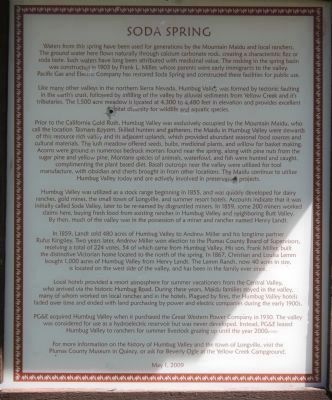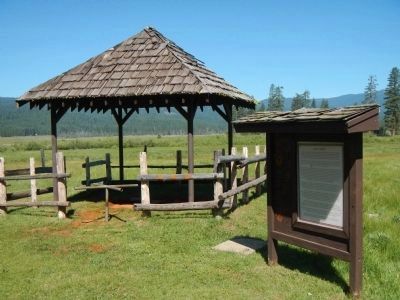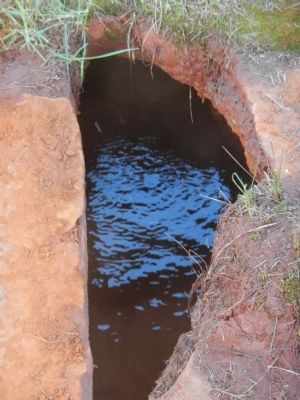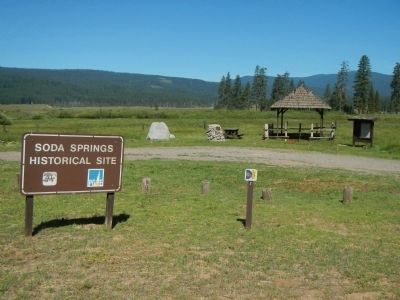Near Chester in Plumas County, California — The American West (Pacific Coastal)
Soda Spring
Like many other valleys in the northern Sierra Nevada, Humbug Valley was formed by tectonic faulting in the earth’s crust, followed by infilling of the valley by alluvial sediments from Yellow Creek and it’s (sic) tributaries. The 1,500 acre meadow is located at 4,300 to 4,480 feet in elevation and provides excellent habitat diversity for wildlife and aquatic species.
Prior to the California Gold Rush, Humbug Valley was exclusively occupied by the Mountain Maidu, who called the location Tasman Koyom. Skilled hunters and gathers, the Maidu in Humbug Valley were stewards of this resource rich valley and its adjacent uplands, which provided abundant seasonal food sources and cultural materials. The lush meadow offered seeds, bulbs, medicinal plants, and willow for basket making. Acorns were ground in numerous bedrock mortars found near the spring, along with pine nuts from sugar pine and yellow pine. Montane species of animals, waterfowl, and fish were hunted and caught complimenting the plant based diet. Basalt outcrops near the valley were utilized for tool manufacture, with obsidian and cherts brought in from other locations. The Maidu continue to utilize Humbug Valley today and are actively involved in preservation projects.
Humbug Valley was utilized as a stock range beginning in 1855, and was quickly developed for dairy ranches, gold mines, the small town of Longville, and summer resort hotels. Accounts indicate that it was initially called Soda Valley, later to be re-named by disgruntled miners. In 1859, some 200 miners worked claims here, buying fresh food from existing ranches in Humbug Valley and neighboring Butt Valley. By then, much of the valley was in the possession of a miner and rancher named Henry Landt.
In 1859, Landt sold 480 acres of Humbug Valley to Andrew Miller and his longtime partner Rufus Kingsley. Two years later, Andrew Miller won election to the Plumas County Board of Supervisors, receiving a total of 224 votes, 54 of which came from Humbug Valley. His son, Frank Miller, built the distinctive Victorian home located to the north of the spring. In 1867, Christian and Louisa Lemm bought 1,000 acres of Humbug Valley from Henry Landt. The Lemm Ranch, now 40 acres in size, is located on the west side of the valley, and has been in the family ever since.
Local hotels provided a resort atmosphere for summer vacationers from the Central Valley, who arrived via the historic Humbug Road. During these years, Maidu families stayed in the valley, many of whom worked on local ranches and in the hotels. Plagued by fires, the Humbug Valley hotels faded over time and ended with land purchasing by power and electric companies during the early 1900s.
PG&E acquired Humbug Valley when it purchased the Great Western Power Company in 1930. The valley was considered for use as a hydroelectric reservoir but was never developed. Instead PG&E leased Humbug Valley to ranchers for summer livestock grazing until the year 2000.
For more information on the history of Humbug Valley and the town of Longville, visit the Plumas County Museum in Quincy, or ask for Beverly Ogle at the Yellow Creek Campground.
Erected 2009 by Pacific Gas & Electric.
Topics. This historical marker is listed in these topic lists: Native Americans • Natural Resources. A significant historical year for this entry is 1903.
Location. 40° 8.518′ N, 121° 14.655′ W. Marker is near Chester, California, in Plumas County. Marker is on Forest Service Road 26N26, on the right when traveling south. Touch for map. Marker is in this post office area: Chester CA 96020, United States of America. Touch for directions.
Other nearby markers. At least 8 other markers are within 10 miles of this marker, measured as the crow flies. Humbug Valley (a few steps from this marker); Tasman Koyom (a few steps from this marker); Baccala Ranch (approx. 6.2 miles away); Seneca (approx. 8.7 miles away); Cedar Chalet Bakery (approx. 9.3 miles away); Feather River Highway (approx. 9.3 miles away); Eby Stamp Mill (approx. 9.3 miles away); Rich Bar (approx. 9.4 miles away). Touch for a list and map of all markers in Chester.
More about this marker. This marker is located at Soda Springs. To reach Soda Springs from Lake Almanor take Humbug Road (County Road 307), then, at approximately mile post 6, take an unsigned road south toward the PG&E Yellow Creek campground. Soda Springs is about one mile south of the intersection.
Credits. This page was last revised on June 16, 2016. It was originally submitted on June 18, 2013, by Barry Swackhamer of Brentwood, California. This page has been viewed 1,224 times since then and 99 times this year. Photos: 1, 2, 3, 4. submitted on June 18, 2013, by Barry Swackhamer of Brentwood, California. • Syd Whittle was the editor who published this page.



